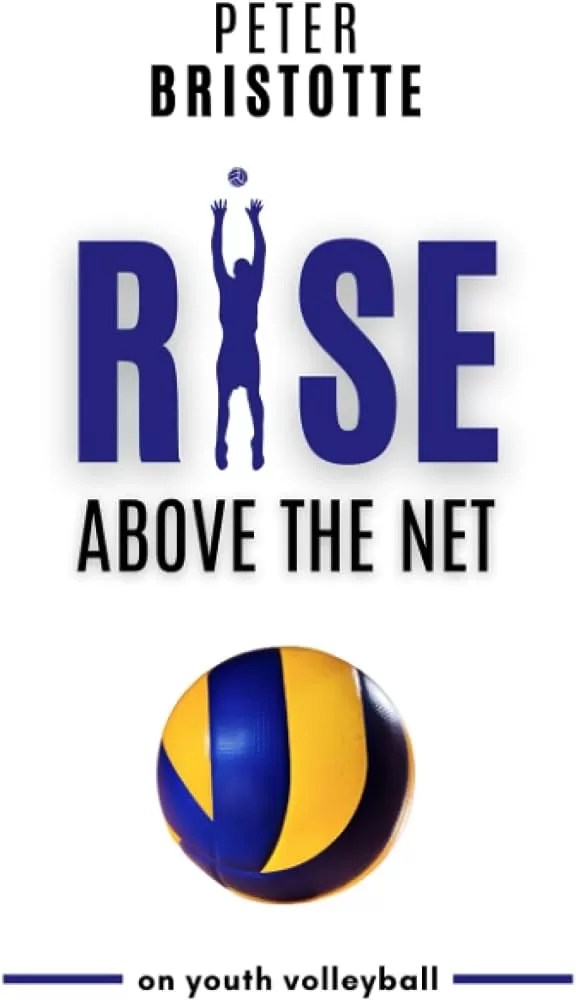I knew early on Rise above the online: on youth volleyball by Peter Bristotte was going to be a difficult learn. It begins with a reasonably detailed and wordy introduction. Issues didn’t get any simpler from there. Frankly, this e-book wanted an editor – each for content material and a few typo/grammatical points. It’s listed at over 650 pages!
This isn’t to say there aren’t good bits. You simply should weed by means of a number of verbiage to get there.
The content material
Chapter 1 is a sort of survey of Western philosophy and the way it can hyperlink to teaching. There are a couple of fascinating observations, however my guess is most readers will at finest skim this half.
The philosophy carries over considerably into Chapter 2, the place the main target is essentially on changing into a coach. The writer little doubt will encourage argument with the opinion that coaches will need to have faculty levels.
Chapter 3 is about analysis. It’s a dense chapter! The ideas mentioned embody blocked vs. variable, meta-cognition, spaced vs. massed observe, retrieval observe, and contextual interference. The tip of the chapter is principally a listing of distinguished researchers and their contributions. With a prolonged bibliography, as effectively.
Chapter 4 begins off speaking about curriculum, however then wanders round. I’m not solely positive if it ever actually locked in on any actual level.
Then there’s Chapter 5. Once I flipped to it I used to be happy to see a quote from John Kessell because the chapter intro. Then I seemed down in my Kindle app and noticed the estimated studying time listed at 56 minutes. By comparability, Chapter 4 was one thing like 38 minutes, and that was undoubtedly lengthy (at the least for me). For sure, I groaned a bit. The titular focus was Fundamentals. It began off speaking concerning the worth of game-like coaching, which I’m undoubtedly in favor of. Then many of the chapter was a skill-by-skill breakdown. Every talent took up a number of pages, which is why it’s such a protracted chapter.
Offensive programs are the first focus of Chapter 6, which is marginally shorter than Chapter 5. The 6-6, 4-2, and 5-1 all get protection. Then Chapter 7 goes into protection and defensive programs. The writer describes issues in some methods new to me, but it surely was straightforward sufficient to folllow.
Chapter 8 turns the main target to what the writer phrases intangibles. Principally, it’s psychology. Going from very detailed chapters instantly prior, this one was unusual. It struck me as fairly superficial by comparability. Form of like, “Right here’s a bunch of books you may learn on the topic.” It’s not till the latter a part of the chapter that I felt just like the writer was actually saying one thing in their very own voice.
Subsequent up was statistics in Chapter 9. The writer covers each group and particular person degree stats, in addition to how they’re completely different for rookies vs. expertise gamers. The beneficial stats to trace are the same old ones, which this present day may very well come off as being fairly simplistic for extra superior readers.
Power and Conditioning is the topic of Chapter 10, which is one other lengthy one (my Kindle mentioned 1hr 16). It begins with a reasonably prolonged dialogue of the worth of bodily health, going as far as to speak about World Well being Group (WHO) tips.. From there the writer has a reasonably detailed dialogue of the three completely different vitality programs concerned in volleyball – ATP-CP, glycolytic, and cardio – and work:relaxation ratios earlier than carrying on by means of various different matters. It is a fairly intense chapter that ends with A LOT of references.
In Chapter 11 the main target turns to observe planning. It begins off with a narrative concerning the firm Kodak as a part of a basic dialogue on the worth of planning. That rolls into speaking about coaching ideas like organic individuality, adaptation, progressive load, and, specificity. The themes of switch, entire vs. half, and random vs. blocked coaching (once more) additionally come into the dialog. After this foundational piece, the chapter then strikes on to easy methods to put a observe plan collectively.
Chapter 12 is largely an evidence of the historical past and present state of Sports activities Science. The ecological method, which is on the core of what Rob Gray talks about in How We Study to Transfer, and the movies right here, is given a number of house.
Dad and mom get the highlight in Chapter 13, which is the final.
Really useful?
Would I like to recommend this e-book? That’s a troublesome query. As I mentioned on the high, there are undoubtedly good bits. You’re very more likely to study from it – should you can keep your focus and a spotlight. It’s that final half the place I battle. It’s simply such an enormous e-book with loads to wade by means of to get to the meaty stuff you’re after. That’s the trigger for my hesitation.
For those who’re the sort who’s in a position to sit down and dive right into a e-book for chunks of time, then this e-book may very well be very helpful. For those who battle to maintain your consideration that approach, I’m considering you’d be higher off getting in a special route.
6 Steps to Higher Practices – Free Information

Subscribe to my weekly publication at this time and get this free information to creating your practices one of the best, together with hundreds extra teaching suggestions and data.

